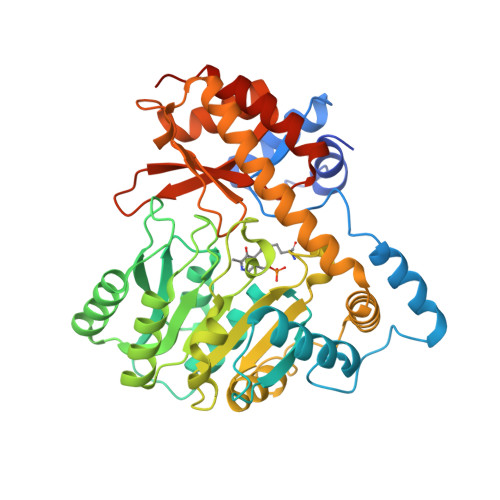Molecular basis for the diversification of lincosamide biosynthesis by pyridoxal phosphate-dependent enzymes.
Mori, T., Moriwaki, Y., Sakurada, K., Lyu, S., Kadlcik, S., Janata, J., Mazumdar, A., Koberska, M., Terada, T., Kamenik, Z., Abe, I.(2025) Nat Chem 17: 256-264
- PubMed: 39643667
- DOI: https://doi.org/10.1038/s41557-024-01687-7
- Primary Citation of Related Structures:
8KDK, 8KDL - PubMed Abstract:
The biosynthesis of the lincosamide antibiotics lincomycin A and celesticetin involves the pyridoxal-5'-phosphate (PLP)-dependent enzymes LmbF and CcbF, which are responsible for bifurcation of the biosynthetic pathways. Despite recognizing the same S-glycosyl-L-cysteine structure of the substrates, LmbF catalyses thiol formation through β-elimination, whereas CcbF produces S-acetaldehyde through decarboxylation-coupled oxidative deamination. The structural basis for the diversification mechanism remains largely unexplored. Here we conduct structure-function analyses of LmbF and CcbF. X-ray crystal structures, docking and molecular dynamics simulations reveal that active-site aromatic residues play important roles in controlling the substrate binding mode and the reaction outcome. Furthermore, the reaction selectivity and oxygen-utilization of LmbF and CcbF were rationally engineered through structure- and calculation-based mutagenesis. Thus, the catalytic function of CcbF was switched to that of LmbF, and, remarkably, both LmbF and CcbF variants gained the oxidative-amidation activity to produce an unnatural S-acetamide derivative of lincosamide.
- Graduate School of Pharmaceutical Sciences, The University of Tokyo, Tokyo, Japan. tmori@mol.f.u-tokyo.ac.jp.
Organizational Affiliation:


















